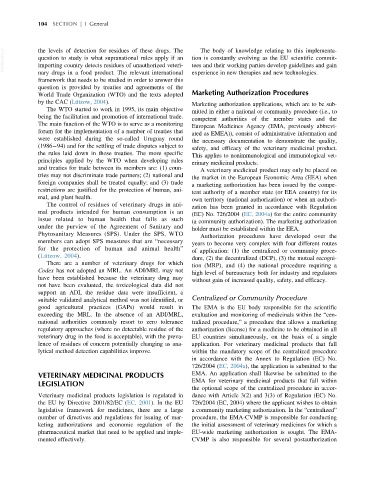Page 137 - Veterinary Toxicology, Basic and Clinical Principles, 3rd Edition
P. 137
104 SECTION | I General
VetBooks.ir the levels of detection for residues of these drugs. The tion is constantly evolving as the EU scientific commit-
The body of knowledge relating to this implementa-
question to study is what supranational rules apply if an
tees and their working parties develop guidelines and gain
importing country detects residues of unauthorized veteri-
nary drugs in a food product. The relevant international experience in new therapies and new technologies.
framework that needs to be studied in order to answer this
question is provided by treaties and agreements of the
Marketing Authorization Procedures
World Trade Organization (WTO) and the texts adopted
by the CAC (Lu ¨tzow, 2004).
Marketing authorization applications, which are to be sub-
The WTO started to work in 1995, its main objective
mitted in either a national or community procedure (i.e., to
being the facilitation and promotion of international trade.
competent authorities of the member states and the
The main function of the WTO is to serve as a monitoring
European Medicines Agency (EMA, previously abbrevi-
forum for the implementation of a number of treaties that
ated as EMEA)), consist of administrative information and
were established during the so-called Uruguay round
the necessary documentation to demonstrate the quality,
(1986 94) and for the settling of trade disputes subject to
safety, and efficacy of the veterinary medicinal product.
the rules laid down in those treaties. The more specific
This applies to nonimmunological and immunological vet-
principles applied by the WTO when developing rules
erinary medicinal products.
and treaties for trade between its members are: (1) coun-
A veterinary medicinal product may only be placed on
tries may not discriminate trade partners; (2) national and
the market in the European Economic Area (EEA) when
foreign companies shall be treated equally; and (3) trade
a marketing authorization has been issued by the compe-
restrictions are justified for the protection of human, ani- tent authority of a member state (or EEA country) for its
mal, and plant health. own territory (national authorization) or when an authori-
The control of residues of veterinary drugs in ani- zation has been granted in accordance with Regulation
mal products intended for human consumption is an (EC) No. 726/2004 (EC, 2004a) for the entire community
issue related to human health that falls as such (a community authorization). The marketing authorization
under the purview of the Agreement of Sanitary and holder must be established within the EEA.
Phytosanitary Measures (SPS). Under the SPS, WTO Authorization procedures have developed over the
members can adopt SPS measures that are “necessary years to become very complex with four different routes
for the protection of human and animal health”
of application: (1) the centralized or community proce-
(Lu ¨tzow, 2004).
dure, (2) the decentralized (DCP), (3) the mutual recogni-
There are a number of veterinary drugs for which
tion (MRP), and (4) the national procedure requiring a
Codex has not adopted an MRL. An ADI/MRL may not
high level of bureaucracy both for industry and regulators
have been established because the veterinary drug may
without gain of increased quality, safety, and efficacy.
not have been evaluated, the toxicological data did not
support an ADI, the residue data were insufficient, a
suitable validated analytical method was not identified, or Centralized or Community Procedure
good agricultural practices (GAPs) would result in The EMA is the EU body responsible for the scientific
exceeding the MRL. In the absence of an ADI/MRL, evaluation and monitoring of medicinals within the “cen-
national authorities commonly resort to zero tolerance tralized procedure,” a procedure that allows a marketing
regulatory approaches (where no detectable residue of the authorization (license) for a medicine to be obtained in all
veterinary drug in the food is acceptable), with the preva- EU countries simultaneously, on the basis of a single
lence of residues of concern potentially changing as ana- application. For veterinary medicinal products that fall
lytical method detection capabilities improve. within the mandatory scope of the centralized procedure
in accordance with the Annex to Regulation (EC) No.
726/2004 (EC, 2004a), the application is submitted to the
VETERINARY MEDICINAL PRODUCTS EMA. An application shall likewise be submitted to the
EMA for veterinary medicinal products that fall within
LEGISLATION
the optional scope of the centralized procedure in accor-
Veterinary medicinal products legislation is regulated in dance with Article 3(2) and 3(3) of Regulation (EC) No.
the EU by Directive 2001/82/EC (EC, 2001). In the EU 726/2004 (EC, 2004) where the applicant wishes to obtain
legislative framework for medicines, there are a large a community marketing authorization. In the “centralized”
number of directives and regulations for issuing of mar- procedure, the EMA-CVMP is responsible for conducting
keting authorizations and economic regulation of the the initial assessment of veterinary medicines for which a
pharmaceutical market that need to be applied and imple- EU-wide marketing authorization is sought. The EMA-
mented effectively. CVMP is also responsible for several postauthorization

